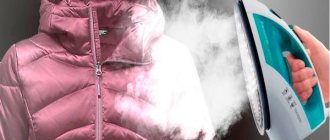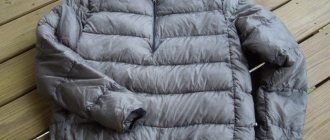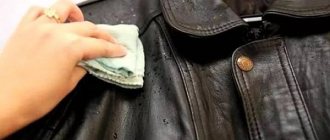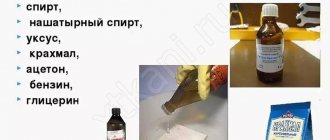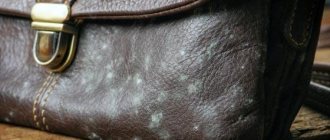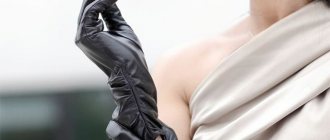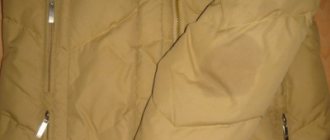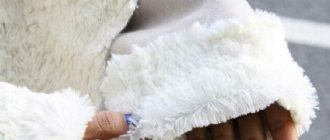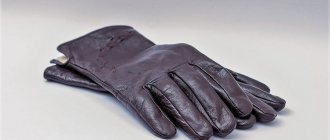One of the basic rules for ridding this item of dirt is to select those cleaning agents and products that have an exceptionally light, milky or transparent color. This is due to the fact that compositions or products with dark shades can spoil the white tone of the product. Therefore, it is not recommended to clean stains with coffee powder, colored products or strong chemicals.
The main rules for cleaning white leather products:
- White leather should not be soaked in water . It is best to clean the product more often, but without using a washing machine or prolonged soaking;
- before using any cleaning composition for the first time, it is advisable to conduct a trial experiment on an inconspicuous area , making sure that the item will not change its color;
- Every time after wearing this item, it is recommended to remove accumulated dust using a soft, damp cloth moistened with plain water;
- Before starting the cleansing procedure, it is recommended to remove all items from the pockets and fasten the existing locks and zippers;
- Wipe the product thoroughly with a soft sponge or brush;
- cleansers must be applied carefully, using smooth circular movements , trying to avoid strong friction so as not to damage the material;
- It is best to dry the item at room temperature, away from heating devices and heaters.
You should try to avoid excessive wetting of the skin, since the material, after being oversaturated with moisture, can lose its shape, become rough and inelastic.
It is recommended to clean white leather items immediately after getting dust or dirt, without waiting for the stain to be deeply absorbed.
How to get rid of scuffs on a collar
The collar always gets dirty quickly, but it is not necessary to take the product to the dry cleaner; you can clean the collar of a leather jacket yourself.
The collar gets dirty quickly due to sebum and sweat
Straighten the collar and carefully clean it in several stages: wipe off dirt with a cotton pad soaked in alcohol, and then rub with lemon juice. At the end of the procedure, lubricate the collar with glycerin and polish with a dry cloth.
To clean your collar less often, wear a scarf or neckerchief
- Alcohol. Helps to get rid of traces of greasy collar and put it in order. The product should be laid out on a horizontal surface so that the treated area is easily accessible. Then soak a cotton pad in alcohol and wipe the difficult area with gentle movements. You cannot act aggressively, as this can damage the fragile material. Next, wipe the cleaned area with lemon juice or orange zest.
- Glycerol. Helps soften rough skin on the collar, can be used after alcohol treatment.
After processing, the product is straightened and placed on hangers for several hours, its appearance is transformed.
Baking soda
When doing the work, do not use much mechanical force, since soda is an abrasive powder, and if handled carelessly, you will have to remove scratches.
Ammonia and salt
Dissolve 1 tablespoon of ammonia and salt (preferably fine) in water. Soak a foam sponge in the resulting mixture and remove dirt. Then rinse the treated area with water.
Combine an equal amount of components and clean the contaminated areas on the jacket with the resulting solution. Remember that these substances are quite aggressive, and rinse the material thoroughly after cleaning.
Onion
Cut a small onion in half and rub the cut across the collar. This method allows you to quickly deal with the problem of contamination, however, after this treatment, the jacket will need to be well ventilated in the fresh air.
Soap solution
Soak a cotton pad in alcohol and wipe the dirty areas. Then treat this area with lemon juice (you can use a slice of citrus).
Once the skin is clean, apply glycerin to the collar. This will soften the material and reduce the risk of cracks.
Gasoline or turpentine
Such cleaning is only possible in cases of heavy soiling. Wipe the collar with gasoline or turpentine, then rinse the material well and send the item to be ventilated in fresh air.
Removing grime
The collar, sleeves, pockets and fasteners of leather jackets get dirty faster, especially for men. When worn, there is constant contact with human skin, and it actively releases sweat and fat, leaving dirty marks on the collar.
What is recommended to properly clean the collar:
- Spread the leather jacket on something flat and hard so that the collar is as straight as possible.
- Take a soft rag or cotton pad and dip it in alcohol.
- Carefully treat the collar, especially the tips and folds (they are the most contaminated).
- Wipe the collar treated with an alcohol solution with lemon juice or orange zest to dissolve greasy stains and eliminate the greasy odor.
- Soften the top of the collar with glycerin.
- Hang the jacket on hangers and wait until the collar is completely dry.
Pockets, fasteners, sleeves are cleaned in the same way as the collar. The main thing is to maintain the neatness of your leather product by cleaning it regularly.
Removing difficult stains
Several types of stains are most common. The table below shows how to display them.
| Paint, mold | Remove contamination with solvent, gasoline or turpentine diluted with milk. Soften the surface of the jacket with castor oil, glycerin or leather cream. To eliminate the unpleasant odor, hang the product in a well-ventilated area, then lubricate it with lemon juice. |
| Ball pen | Moisten a cotton pad with alcohol and wipe the stained area. |
| Salt stains | Use regular vinegar for cleaning. |
| Blood | Several withdrawal methods: Immediately wash away the red stain using soap suds and cold water. Use hydrogen peroxide after first checking the reaction of the jacket's skin on a less noticeable area. Apply aspirin dissolved in water. |
Regular care
In order for a leather jacket to remain “like new” for a long time, you will have to take care of it regularly. It is enough to do this monthly or once every 3 weeks: monitor quickly contaminated areas (collar, fur, sleeves, pockets, fasteners) and wash them immediately.
- Prepare a regular soap solution with a couple of drops of ammonia.
- Take a soft flannel cloth or a non-hard sponge, soak it in the solution, carefully clean the leather jacket where the most dirt is, or better yet, apply it to the entire thing.
- Rinse the surface of the leather product with regular running water and wipe it dry without any extra effort.
- Lubricate cleaned, dried skin with castor oil or a special cream for leather surfaces.
In order not to spoil the appearance and quality of a leather jacket or leatherette jacket, it is recommended to carefully study the information about the care method on labels or tags, following the simple rules described above.
Traditional methods of cleaning
If for some reason the above method does not suit you, then you can resort to other traditional methods of cleaning leather items.
Rubbing with onion juice
Cut the onion in half and take one piece. Rub the oily areas by pressing firmly on the vegetable. Onion juice is safe for the skin, but is effective when treating areas where the material is shiny. Therefore, you can safely use this method regularly.
The specific pungent odor of onions can be removed with a soap solution. Dampen a small cotton cloth in it and wipe the entire surface of the product. After this, lubricate it with cream and wait until the composition is absorbed into the material.
Egg white treatment
One egg will be enough to remove several stains. If the whole jacket is dirty, then use the whites of 2-3 eggs:
- Beat them until smooth and apply evenly to the surface of the clothing using a sponge.
- Leave the mixture for 3-5 minutes, then remove it with a damp cloth.
This method is considered gentle on the material, so it is allowed to apply the mixture several times in a row until the contamination is removed.
Hydrogen peroxide cleaning
It should be noted that this method is only suitable for cleaning a white leather jacket, as well as light-colored items. On dark things, the solution will leave streaks of mixed colors, which will lead to their damage.
Soak a cotton pad or dry cloth in peroxide and go over the greasy stains. There is no need to rinse off the solution.
Cleaning with dishwashing detergent
Dish soap will help get rid of greasy stains. It contains components that remove greasy stains from any surfaces:
- Apply a few drops of detergent to a cotton pad or sponge and rub onto shiny areas on the collar, sleeves and pockets.
- If the stains are old, leave the soap solution on the jacket for 10 minutes.
- After this, wash it off with a damp cloth.
- Since any soap composition includes alkali, which dries out the material, after the procedure, lubricate the clothes with a nourishing cream.
- Hang it on a hanger and wait until the product is absorbed.
Methods of cleansing: step-by-step instructions
In order to effectively remove stains and grime, you can use simple folk recipes that will return the product to a fresh and neat appearance without thinning the structure of the material or changing color.
Using soap solution
The soap solution very well cleans stains from cosmetics and dust, and also returns the product to its snow-white appearance. Preparing this composition is very simple:
- Dilute the required amount of baby soap without additives or fragrances in a liter of warm water. The soap should be white or light milky in color;
- Wipe the contaminated area with a soft sponge or cloth soaked in solution.;
- blot the washed area with a paper towel , removing excess moisture;
- To make the material soft after cleansing, you can treat the area with castor oil.
Milk or lemon
Using milk or lemon, you can quickly and effectively remove fresh stains, as well as get rid of grease and grease on sleeves, collars and pockets.
- In a small container, lightly heat half a glass of low-fat milk;
- Apply warm milk to light skin with a soft cloth and lightly rub the problem area;
- After the contamination disappears, treat the surface with a dry, soft cloth..
- squeeze the juice from one lemon and apply it to the yellowed or greasy area;
- hang the product on a hanger and leave until completely dry.
Milk helps restore brightness to the white color, and lemon works great against yellowing stains.
Cleansing with toothpaste
Toothpaste with a whitening effect will remove dirt and dust, and also lighten the material, adding brightness and well-groomed appearance to the item:
- Using a soft brush—shoe or toothbrush —apply a small amount of toothpaste to the stain;
- Lightly rub the paste into the skin using smooth circular movements;
- If necessary, the product applied to the contaminated area can be left for several hours or overnight;
- the next morning, wipe the area with a damp, soft cloth moistened with plain water;
- leave the item to dry naturally , hanging it on a hanger.
Eraser
Scuffs, grease and slightly ingrained stains can be easily removed with the help of an ordinary new eraser, which should be used to lightly rub the problem areas.
Algorithm: how to clean a leather jacket from dirt without a washing machine.
1. Prepare a soap solution using warm water.2. Place clothing on a hard surface.3. Dampen a soft-textured sponge (rag) in a watery substance and begin to move carefully over the material. First clean the leather, then proceed to the lining. Squeeze the sponge firmly so that no excess moisture remains on the product.
Cleaning a leather jacket without a washing machine
4. Cleaning method - stripes. Repeat the manipulations 2-3 times.5. Change the water once.6. The final treatment will help remove any remaining cleaning powder to prevent streaks from appearing after washing. If you overuse it with water, deformation will occur when it dries.
7. Place the item of clothing on hangers and leave it to dry in the room. Do not wear the product when it is wet, otherwise it will stretch. And, conversely, you can wear leather shoes in this way.
Drying a leather jacket
8. How to clean the lining of a leather jacket? Hang it on a hanger with the lining facing out. Take a soft brush, dilute the soap solution and treat the fabric. You can flog her, but it will take extra time
Rinse off the powder or soap carefully with a stream of water so as not to touch the skin. If there are old stains on the lining, wash them off with vinegar first.
You can even prepare two basins: place a soap solution in one, and vinegar in the second.
Leather jacket lining
For thin and soft skin, if it is not very dirty, wet wipes will come in handy. Just wipe local areas of contamination. The store offers an assortment of professional cosmetics.
How to iron a leather jacket
If you clean a leather jacket with impregnation, this product will return the items softness and shine, and protect the color, which is important for dyed leather. She won't fade in the sun
Impregnation is also used for cleaning artificial and now popular eco-leather.
If you want to iron your jacket, this is allowed, but in the “wool” mode and through gauze folded in 3-5 layers. An option is to use an iron with a steam function.
What not to do
Along with recommendations, there are also “contraindications”, which should never be done when it comes to cleaning light-colored leather items. Many housewives are mistaken in believing that they can speed up the drying process of clothes or shoes made of genuine leather by placing them on a radiator. This action can lead to drying out of the material and the appearance of cracks.
In such cases, it is better to use a soapy solution for cleaning. After completing the procedure, the item must be dried with a paper towel. If it comes to machine washing, then you should set the delicate mode without spinning.
Soft, light-colored skin requires special care. For cleaning or coating, you cannot use creams and sponges that are used for dark leather shoes and clothes. Snow-white shoes made of natural material cannot be stored next to colored items. This is fraught with tarnishing of an expensive product.
Cleaning white leather at home is not an easy task, but it is quick. It is enough to correctly determine the degree and type of contamination, select suitable folk or chemical remedies and thoroughly wash the traces with a soft sponge. All that remains is to dry and air things out, after which clean clothes can be worn outside again.
... specific pollution
Oily stains are not all that the skin is afraid of. There are a number of specific contaminants (for example, from pens and blood) that need to be dealt with quickly. For example, dried blood from the skin is much more difficult to wash off than fresh blood. What to do if you don’t have any special store-bought products at hand?
- Ball pen. Mix medical alcohol and heated glycerin (1:1). Soak a cotton pad in the mixture and apply to the painted area. You can also sprinkle a heap of damp table salt onto the ink squiggle. After two days, clean the area of powder and wipe with a rag soaked in turpentine.
- Salt stains. Soak a cotton swab in table vinegar and treat the contaminated areas. A solution of laundry soap is also suitable (30 g of shavings per liter of water).
- Blood. Treat with cold soapy water, moving from the edges to the center. The enemy of this kind of “blot” is hydrogen peroxide. But this substance may change the color of the product, so test first. Aspirin can also remove blood stains. Dissolve one tablet in a glass (250 ml) of water.
How to care for a leather jacket using folk remedies
In order for the leather to last longer and not become cracked, it is necessary to soften it, especially in cases where you use soap or washing powder to clean the surface. These substances perfectly remove dust and dirt, but dry out the material, making it brittle and inelastic.
To soften your skin, you can use the following products that every housewife can find. They must be used after first cleaning the jacket from dust and dirt using a damp sponge or soft cloth. You can apply the compositions when the skin is dry.
Ammonia and glycerin
Treat your leather jacket with a cotton swab soaked in ammonia; this will help remove excess oil from the leather, which you cannot always remove by wiping the material with a sponge.
When the caustic substance evaporates and the surface becomes dry again, apply glycerin to the skin. In order for the product to be evenly distributed throughout the material and absorbed faster, preheat it in a water bath.
Castor oil and egg white emollient
Beat the white of one egg into a strong foam and add 50 ml of castor oil. Mix the composition to obtain a homogeneous mass, and treat the leather jacket with foam rubber soaked in a homemade “softener”.
Soap solution with fish oil and ammonia
Grind ½ bar of laundry soap on a grater and dissolve the shavings in a liter of hot water. When the composition becomes homogeneous, pour in a teaspoon of fish oil and 3 tablespoons of ammonia. Stir the solution again and, after soaking a cotton swab in it, distribute the softening agent evenly over the jacket.
Butter and ammonia
Mix warm water and butter in equal parts, and then dilute with ammonia. The amount of ammonia should be three times less than oil and water.
Bring the mixture to a homogeneous state, stirring constantly, and then apply it to the skin using a cotton swab or disk.
"Care" products
The skin is sensitive to aggressive reagents and high temperatures. Over time, the product dries out, cracks, and loses color. Therefore, you should carefully choose the care products for your leather jacket.
Professional
In a leather goods store, manufacturers offer related “care” products. Professional products delicately preserve the structure of the material, help fight dirt and prevent stains. Among these are:
- protective cream - used regularly to prevent cracks and abrasions;
- cleansing wipes - non-aggressively remove dirt and static electricity;
- stain remover - delicately cleans the surface of difficult stains;
- conditioner (oil emulsion) - softens and restores the material;
- waterproof spray - creates a water-repellent layer and retains the shape of the product.
The listed products will preserve the cleanliness and integrity of outerwear and shoes made of genuine leather.
Folk
In addition to special sprays and ointments that keep the jacket clean, shiny and bright, it is recommended to use folk remedies. Substances that cope with local pollution can be found at home or will not be too expensive for the family budget. The main substances for cleaning leather surfaces at home are listed in the table.
Table - Home Remedies and Their Effects on Leather Jacket
| Means | Impact effect |
| Ammonia | — Refreshes clothes and eliminates grime |
| Talc | – Whitens light-colored clothes |
| Vinegar | — Removes dirty stains |
| Solvents | — Removes greasy stains and gets rid of mold |
| Lemon juice/egg white | - Add shine to the product |
| Glycerin/hand cream/vaseline/castor oil | — Moisturize and soften the material |
Purified gasoline or solvent (white spirit) should be used with caution to remove oily, greasy, fuel oil stains. The difficult area is blotted with a cotton swab soaked in solvent, and then wiped with a damp flannel cloth. Strong products should not be used on thin skin. It is not recommended to leave solvents on the surface for a long time. To be sure, you should test the effect of the reagents on a small area of skin.
What types of genuine leather are jackets made from?
To avoid having to clean the leather items that have settled in your wardrobe too often, take care of cleaning them in advance. To safely use various cleaning products at home, you should take into account the type of animal from whose skin the product is sewn:
- ox or buffalo leather is considered the most durable, but things made from this type of material are expensive;
- For outerwear, pigskin is often chosen; clothing is much cheaper, but its service life is much shorter;
- Lambskin is of higher quality than pork, products made from soft material are easier to cut and sew;
- clothes made from goatskin are distinguished by the pleasant softness of a fairly dense material;
- Products made from horse leather will last the longest, but have the highest price.
Constant or frequent wearing of your favorite item leads to the fact that the appearance of the leather fabric loses its attractiveness due to the appearance of stains and grease in some places. The easiest way is to entrust your favorite item to dry cleaners, but in modern life, not everyone can afford the services of professionals. If you are not going to take your leather jacket to the dry cleaner, it will be useful to find out how you can quickly and effectively clean it at home so that you look stylish and beautiful in your favorite clothes, and the product itself will last a long time.
Precautionary measures
Before using any cleaner, try it on an inconspicuous piece of leather from the underside of the item. Here's how to check if a jacket is waterproof. Spray a little water from a spray bottle onto the skin from the inside out. If the wet surface has darkened, it is not recommended to use aqueous solutions to clean the jacket.
In any case, you can’t get the entire jacket too wet, because after drying it shrinks and can change structure and color. Based on this it follows that:
- Do not soak a leather jacket;
- You cannot use a washing machine;
- If the lining does not come off, then it must be washed very carefully.
At home, you can only influence certain areas. Usually the areas that get dirty the most are the cuffs, the area where they touch the neck, and the pockets. Sometimes stains from grease or ballpoint pens may appear, as well as splashes of dirt from walking.
Getting rid of stains
Attention!
It is not advisable to immediately put on a freshly cleaned jacket. The item may stretch.
Wet wipes should not be used to clean light stains. They contain alcohol, which degreases the surface. The product will lose its shine and become matte.
For greasy stains, use a mixture of turpentine and talc. Using a cotton swab, apply the product to the desired area. Glass with a weight is placed on top to press down. After drying, clean with a soft brush and wipe with a damp cloth.
We recommend
A good remedy is laundry soap. It is necessary to lightly soap the area with the greasy stain. Apply with a damp sponge on top and rinse thoroughly with water. A brush should not be used as it may damage the material.
If the grease stain is old, you can clean it with a soap solution and ammonia (a few drops).
- alcohol;
- petrol;
- acetone;
- liquid dish soap;
- light solvents (white spirit).
The procedure is simple - moisten a cotton pad with the selected composition and walk over the greasy stain.
Manufacturers also produce special products for cleaning leather materials. They remove dirt as much as possible without causing harm. Among them are such products as: Leather Ultra Clean, Kozhanka, Beaute Cuir, etc.
When used, the composition is sprayed onto the surface and treated with a sponge. Finally, the residues are cleaned off with a dry soft cloth.
Home methods
Many newly purchased jackets are rough and cause discomfort: they interfere with the movement of the body, the arms are constrained, the collar rubs the neck.
What does each person do with tight shoes? That's right, it wears it out. This is how you can “break in” your jacket:
- Watching TV at home will help make the jacket more comfortable: to do this, just put the thing under a blanket or even under a pillow, sit on it for an hour and a half or two, enjoying watching your favorite movie.
- Dancing on a jacket: place the item on a clean floor, cover it with a thin cotton cloth and dance on it with bare feet. The method is also called the “winemaker’s method”, because from the outside it looks like squeezing juice from grapes.
Of course, “chemical methods” is too strong a name. You can only use substances that will not destroy the structure of the item and will help soften it. These include:
- Mink oil. It looks like this step by step: the jacket needs to be heated to open the pores of the skin. This can be done by placing the item on the battery for 5-10 minutes. Then carefully spread the mink oil evenly over the entire surface with a cotton swab. Leave the oil for eight hours, or better yet, overnight. Remove the remains with a piece of gauze.
- Castor oil. The application method is the same as in the first option. You should not use regular vegetable oil: the item may deteriorate and the skin may become even rougher.
- Petrolatum. Method of application is the same as with mink and castor oils.
- Regular lemon or orange. These fruits contain fruit acids that have a gentle effect and soften the item. You need to squeeze out the juice of citrus fruits, dilute it in a ratio of “one part water and two parts juice”, use a cotton swab to treat the entire surface of the jacket, leave to dry for two hours, then repeat the rubbing, let it absorb, and rinse off the residue. But you should be extremely careful: lemon can discolor the jacket, not much, but the item will lose its brightness.
- Egg whites. Two or three egg whites will soften a jacket perfectly. But the amount of proteins can be increased depending on the size. The egg whites are whipped into a soft foam. Then apply a napkin to the entire surface. Leave to dry for approximately five to six hours. Then remove all residues with a damp cloth or simply moistened gauze.
Household chemicals
If natural remedies do not help, you can try household chemicals. The following methods will help improve the quality of your leather jacket:
- Shoe polish and baby cream. Here the item does not need to be heated. Mix shoe polish, preferably colorless, with baby cream in a 1:1 ratio until smooth. Then use a cotton pad to spread evenly over the entire surface. Leave the jacket overnight to absorb, and in the morning remove the remaining mixture with clean gauze. Shoe polish must be of high quality and contain wax. You should not spare money to buy baby cream. It should be dense and greasy in texture.
- Using air conditioning. You can use either a purchased product or prepare it yourself. Before applying commercial conditioner, the jacket should be cleaned of external contaminants. Then treat the item with leather conditioner and leave for one to two hours. Wash off any remaining residue with a damp cloth. If the conditioner does not contain wax or oils, you can prepare it yourself: mix conditioner, propolis and castor oil in a ratio of 2:1:1, then apply to the item.
Cleaning white and light skin
How to clean a light leather jacket at home without leaving dark stains on it? The process must be approached carefully. It is prohibited to use coloring substances and products such as coffee grounds, orange peel
Lemon is allowed, but only in juice form. The zest can also leave colored spots.
Often, bleach is used to clean a white leather jacket at home. This product does an excellent job of removing food stains, greasy stains, salt stains and dust. You can use lemon juice as a whitening agent, but it is better to buy a special solvent designed for a specific skin type.
You can quickly and effectively clean a white leather jacket at home in the following ways:
- a paste of soda and water applied to the stain and left until completely dry (helps against greasy stains);
- turpentine and talc mixed in equal proportions (suitable for any contaminants);
- a mixture of milk and egg yolk (refreshes, adds shine, hides scuffs).
But just a light leather jacket cannot be cleaned of dirt with bleach at home. If even the weakest, pastel dye is present, the drug can partially remove it, leaving unsightly white spots. Therefore, beige, lemon and other lightly colored leather products are best cleaned with lemon juice and soap solution.
On a note! Is it possible to baptize a child during the Advent Fast?
Choosing a product depending on the color of the jacket
Leather products do not have a wide range of colors, but when cleaning, you should carefully select the products as they can negatively affect the appearance of the jacket. There are 3 main variations of outerwear shades:
- Light products. For them, it is recommended to clean your leather jacket at home or take the items to professionals. You can remove stains from beige or white items with beaten egg whites. Using the resulting foam, the surface of the product is treated, after which the item is washed under running water and wiped dry. A white jacket can also be cleaned with nail polish remover, but it is best to use it only as a last resort.
- Things are brown and red. To clean a genuine leather jacket of this shade, you need to use half an onion or a soap solution. It is not advisable to use gasoline to remove stains, as it may leave dirt behind.
- Jackets in dark colors. The most unpretentious products that can be treated with any cleaning agent. The only exception can be a solution of water and chalk in a ratio of ½, since after such treatment white stains and stains remain on the surface.
It is not recommended to use cleaners made from citrus peels as they give the light coating a yellow tint that is difficult to remove. Professional compositions for caring for jackets include creams, sprays, conditioners, shampoos, and wipes. For maximum results, any product must first be tested on an inconspicuous area.
You can remove stains from beige items with beaten egg whites.
A white jacket can be cleaned with nail polish remover. For brown and red items, onions are used.
Dark-colored jackets can be treated with any cleaning agent
How to remove ink from a leather jacket?
Few people will like ink on a leather jacket. There is an opinion that it is almost impossible to remove such stains and an item damaged in this way must be disposed of. Indeed, removing ink is not very easy, but it is possible. To save your leather jacket, try one of the options presented:
- A fresh stain will help remove the liquid that contains alcohol. Take a sponge, moisten it with the product and use it to remove the ink. This method is harmless and suitable for any skin. The only requirement for this method is to act quickly before the stain dries and the ink is embedded deep into the fabric.
- For this method we will need a little detergent, literally a drop (don't use too much as the solution will be very soapy), water and salt. So, mix the indicated products in such proportions that you end up with a porridge-like mixture. Spread this mixture onto the stain and let it dry. After this, use a brush to remove any remaining product and wipe the area with a damp cloth.
Removing ink from a jacket
- You can try to get rid of ink using tape. To do this, estimate the size of the stain and cut a piece of tape corresponding to its size. Carefully stick it onto the ink and run your hand over it a couple of times. After this, slowly remove the tape, and remove its remnants with an eraser.
- Nail polish remover that does not contain acetone also helps fight ink. Take the product, moisten a sponge with it, and then wipe the problem area with this sponge. You will see ink streaks on your skin, take a clean, non-hard cloth and remove these streaks.
- An alcohol solution with a 10% concentration will also help get rid of such stains. Soak a cloth or cotton wool in the product and remove stains with it. We carefully wipe the place where the ink was with a damp cloth, and then dry it.
Stubborn stains
How to clean a white jacket if the dirt is ingrained? Radical remedies will help you, but you need to use them carefully.
Talc and turpentine. Mix the ingredients so that you get a mass with the thickness of sour cream, scoop the mixture with a cotton swab and apply to the stain. After this, cover the area to be treated with glass and press down with a press. When the mixture has dried, remove the press and clean the skin with a soft brush and then with a damp cloth.
Petrol. Universal cleaner. Dampen a clean white rag in it and wipe the stain. Cloths need to be changed when they become dirty. When the surface is clean, treat it with lemon juice.
Gasoline and white magnesia. White magnesia acts on the principle of talc, and gasoline in this case acts as a solvent. The components are mixed until creamy and applied to the contaminated area. Unlike talc, magnesium does not require a press; it simply needs to dry on the skin, after which it can be brushed off with a soft brush.
Alcohol and vinegar. Alcohol does an excellent job of removing any dirt, but this product is quite aggressive. In order not to spoil the leather, mix it with regular table vinegar in equal proportions, and use this mixture to remove stubborn stains. Dampen a cloth in it and wipe the stained area, and then dry the skin with a clean towel.
Organic solvents. Suitable for removing the most difficult stains - paint, ballpoint pen, ink, varnish. The solvent used is nail polish remover, turpentine diluted in cow's milk. Acetone, white alcohol and more aggressive products are not suitable, as they can damage not only the superficial, but also the deep layers of the skin. Before using solvent, test it on the underside of the garment.
Caring for a leather jacket at home
Caring for genuine leather jackets is a simple process. From the information on the label it will be clear whether the product can be washed at home and whether it is permissible to iron wrinkled areas. In order for a leather item to retain its original appearance longer, it is enough to follow simple rules:
- The leather jacket should hang on a wide plastic hanger of the appropriate size.
- When stored in a closet for a long time, the leather must breathe; sometimes a cover made of natural material is put on top.
- Conditioner should be applied to the skin once a week. A special product keeps the natural leather of the product moisturized and prevents it from becoming rough.
- After rain, white streaks may appear on the surface of dark skin. They are easily removed with a damp cloth, then the surface is treated with leather spray.
After treatment with special products, the skin gets less dirty, and all contaminants are removed much easier.
Leather clothing is not intended to be worn in rainy weather. If you do happen to get caught in heavy rain, the jacket should be dried properly. First, the product should be laid out on a horizontal surface and a terry towel should be placed inside, it will absorb water. After removing moisture from the inner surface, the jacket is dried on hangers in a well-ventilated area, away from heat sources.
How to remove unpleasant odors and other final tips
Here are six more tips on how to care for and clean your leather jacket quickly and efficiently.
- Use a spray. Clothes will remain soft after cleaning and will not lose their shape, and will also become less dirty if you treat them with a water-repellent spray after they are completely dry.
- Wax. Periodically rub winter items with wax, which provides protection from snow and preserves the color of the item.
- Repair with special glue. You can get rid of scratches using “liquid skin” - a product that glues and masks damaged areas. Drop it onto the damaged area and wait until it dries.
- Keep it in a case. Before you send your outerwear to rest for the summer, clean it from dust and place it in a cover made of breathable material specially designed for this purpose.
- Follow the smell. To get rid of a specific aroma, hang the item in front of a bathtub filled with hot water with the addition of one or two glasses of vinegar. Wait three hours. If you don't know how to freshen a leather jacket from the smell of sweat and tobacco, spray a weak vinegar solution on the fabric. You can also place the item on a horizontal surface and sprinkle it with freshly ground coffee. After 12 hours, or better yet after 24 hours, shake the powder.
- Rub until shiny. Orange peels or glycerin will help restore the shine to leather outerwear. Wipe the surface of the product with them, and it will not only shine, but also become soft and protected from creases. Do not use the zest to treat light leather jackets - red stains may remain.
To easily remove stains from a leather jacket and take care of the product at any time, you can buy a ready-made set of products. This includes cream, cleaner, and special brushes. But first, always read the information on the product label. After all, not all drugs are universal. There are special designs for certain types of skin, for dark and light tones.
Jacket care
Have you ever wondered whether a leather jacket is cleaned after it gets dirty? Definitely! However, this should not be done every day, but only from time to time and only in those places where it is most noticeable.
If you notice that sleeves, zippers, pockets or buttons don't look as good as you'd like, it's a good idea to give them a good cleaning. To do this, it is usually enough to use a simple soap solution with a small addition of ammonia. For more serious contamination, other methods will have to be used.
That is, if there are no difficult stains on the surface of your outerwear, then you can carefully clean it with a regular cloth and soap solution. This procedure will refresh the jacket, and you won’t have to wash it all. However, if the item of clothing is very dirty, then you should resort to using more serious methods, which will be described in the following sections.
In what cases is it better not to wash a down jacket?
If your down coat gets dirty, don't rush to throw the whole thing into the washing machine. There are several circumstances when you definitely shouldn't do this.
Firstly, if such an indication is on the label. Don't neglect this. Otherwise, you risk getting a shapeless pile out of the machine, which will never take on the appearance of your favorite down jacket.
Secondly, if there are only one or several stains on the jacket. Most of all, down jackets do not tolerate frequent washing. Each time, the property of moisture resistance and windproofness gradually disappears. And if a full wash can be avoided, then it’s better to do so.
Thirdly, if the down jacket has leather elements. This is capricious material. Maybe it will just shrink, deforming part of the thing, or maybe it will fade and eventually ruin it all. In any case, it is better to clean the down jacket without washing it.
Cleaning dark gloves
Most often, people purchase leather accessories in dark colors: from different shades of brown to black or dark blue. Or even dark red. They are more practical, fit better with other things, and last even longer, because signs of wear are less noticeable on them.
Cleaning gloves depends greatly on their color. Dark products cannot be treated with products that contain bleaching components.
Soap
The easiest way to clean leather gloves from dirt is with a soap solution:
- Mix warm, not hot, water with soap shavings, dishwashing gel or a small amount of laundry detergent to create “soapy” water.
- Wear one glove on your left hand, and on your right hand, which you will be cleaning, it is better to wear a protective nitrile work glove to protect your skin from the cleaning agent.
- Lightly soak a cotton pad, soft cloth or fiber cloth in the soapy water and wipe the surface with it.
- Do not wet the haberdashery too much.
- Lay leather items to dry horizontally, preferably on a towel, so that the water is absorbed immediately.
Vinegar + alcohol + water
This home method is suitable for cleaning noticeable dirt and will also get rid of unpleasant odors, if necessary. Vinegar adds shine and eliminates odor. The alcohol will cleanse the skin of dirt. Water will soften this seemingly “nuclear” composition.
Procedure:
Mix all ingredients equally. Apply to skin using a soft cloth or sponge using circular motions. Clean and see: if the stains are not gone, repeat the procedure. Wipe the surface with a cloth soaked in clean water. Dry away from radiators or sunlight - this is an important condition; its violation will cause cracking of the skin.
Ammonia
A mixture of water and ammonia solution will help get rid of stubborn dust and abrasions on dark items:
- Take a small plate or other container.
- Pour 100 ml of water into it and about 1/4 of this amount of ammonia (1 tbsp is enough).
- Soak a soft cloth in the resulting solution.
- Clean away dirt.
- Be sure to wipe your gloves with clean water.
After such cleaning, it is better to dry the products directly on your hands, since treatment with ammonia can cause them to decrease in size and become rough.
After the products have dried, rub them with baby cream, castor oil or any other emollient.
Gasoline + turpentine
The most radical way to help clean leather gloves from serious dirt is as follows:
- Mix 1 part gasoline in 2 parts turpentine.
- Soak a rag in the mixture and treat the leather surface.
Be prepared for a strong, strong odor. Don't worry, it will disappear over time, but we recommend carrying out such aggressive cleaning at the end of the season, when you can forget about protecting your hands from the cold for several months.
Ways to clean a leather jacket at home
For a leather jacket to always look beautiful, it needs care from the moment of purchase. If there is no heavy contamination, it should be regularly wiped with a damp cloth, this will help remove dust and other dirt.
Cleaning a leather jacket with soapy water You can wipe the leather of the jacket with a soap solution, which is applied to the skin with a sponge and then rinsed off. You can add a few drops of ammonia to the soap solution. After cleaning, the jacket should be wiped well with a dry cloth and hung on a hanger. During the cleaning process, you need to avoid getting liquid on the inside of the item; you also don’t need to wet the skin too much, as it may become deformed.
The following home remedies will help remove minor dirt and skin discharge:
- glycerol;
- lemon juice;
- water;
- foam sponge;
- alcohol.
Lemon juice should be mixed with a small amount of water, add 1 teaspoon of alcohol. Soak a foam sponge in the prepared solution and wipe the problem areas of the skin. Take a dry cloth and wipe the wet areas well, then apply a small amount of glycerin to the jacket and wipe well. The whole jacket needs to be treated with glycerin, it will give it freshness and shine. Then hang the jacket on large hangers and set it to dry. Dry your leather jacket at room temperature.
Result before and after cleaning the jacket. When worn for a long time, abrasions appear on a leather jacket, which significantly spoil its appearance. In such cases, you can use a special colorless skin cream, or apply orange peel, which you need to wipe the faded areas of the skin. Orange peel contains a large amount of essential oils, which can easily restore shine to leather products.
Watch this video on YouTube
How not to spoil the product
The first and most important rule: washing a leather jacket is prohibited, as is any soaking or excessive moisture. Any product should always be tested on an inconspicuous area of skin.
Leather products have different densities, so cleaning requires different methods and products. So, for dense ones, a soap solution is suitable, but mechanical friction can be more intense. Medium-density and thin leather requires very careful care, otherwise the surface can be irrevocably damaged.
Cleaning a light leather jacket carefully
We handle light-colored products with the utmost caution. Let us remind you that suede, velor, nubuck jackets are first dry cleaned using a special brush
Additionally, you can use an eraser, a crust of stale bread, or a sponge.
Let us remind you that suede, velor, and nubuck jackets are first dry cleaned using a special brush. Additionally, you can use an eraser, a crust of stale bread, or a sponge.
You can try the above remedies. But it is necessary to test. Since incorrectly selected products can leave a noticeable mark that is difficult to neutralize later. It is better to use methods that are most suitable for fair skin.
These include:
- soapy water with ammonia;
- brushing with tooth powder;
- the use of alcohol and vinegar;
- magnesium oxide, starch, aspirin;
- aviation gasoline.
Specific cleaning methods at home include:
Talc and turpentine
The most effective remedy for heavily soiled areas and stains is the use of talc and turpentine. To do this, take them in equal parts, make a slightly thick paste, and lubricate the contaminated area. Glass and pressure are placed in this place and left until the composition dries on the skin. Then clean with a dry sponge.
Milk cleaning of jacket
Using a terry cloth, apply slightly warmed milk with a few drops of castor oil to the jacket. When the milk dries, wipe the skin with a dry cloth. And go through the fleecy leather with a suede brush.
Onion peeling
We take only a white onion, cut it and rub the dirty places until the onion darkens slightly. Then we wash everything off with a napkin, soak it in water and dry it. Wait until the smell dissipates, or go over the surface with ammonia.
Milk or lemon
For simple stains, a white jacket can be cleaned with cow's milk. You need to pour some milk into a saucer. Then take a soft cloth, soak it in milk and wipe the outer surface of the jacket. Small impurities will be wiped off, and the skin itself will become a little softer thanks to the fats contained in the milk.
If there is a need to bleach and clean a slightly yellowed leather jacket at home, then use natural lemon, or rather, its juice. You need to squeeze the lemon into a cup, moisten a cotton swab with the juice and carefully, but with light movements, wipe your jacket with it.
It is often not worth using bleaching, since the protective layer can be irreparably damaged.
In the collar area
First of all, to keep the collar as little as possible, you need to use neckerchiefs and, in cool weather, scarves. To clean the collar, use the same ingredients described above for greasy stains.
An effective way to clean a leather jacket in the collar area is:
- First, remove dirt from the collar with a swab moistened with alcohol.
- Then rub with lemon juice. An alternative to this can be orange peels.
- Then the surface of the gate is softened with glycerin.
In the event that there are concerns that the item may be damaged or traces of stains will remain, use the services of professionals - take the jacket to the dry cleaner.
Let us recall some rules for handling leather products:
- Try to let things dry if they become saturated with moisture. Do not hang them immediately in a closed closet.
- To prevent deformation of the product, do not hang it on hooks, but use hangers.
- Try to clean stains immediately after they form.
- Test the products you use to clean your products.
- In places of greatest contact with the skin, try to use cushioning materials and accessories (scarves around the neck, removable pads in the armpit area).
- Use leather care cosmetics, conditioners, and impregnations. Use those recommended for this type.
All this will give your leather jacket an attractive and updated look.
A few additional tips
There are special products for caring for leather jackets. They must be purchased along with the purchase of leather clothing and used regularly, then the product will retain its presentation for a long time. If we continue the conversation about inexpensive home methods, then we can add a few more tips:
- Rub a clean leather jacket with egg white, having previously beaten it. This gives outerwear a shine.
- Softness at home is ensured with the help of glycerin. They moisten the swab and wipe the surface. Since glycerin is transparent, this method is quite acceptable for a light jacket.
- When it becomes necessary to dry the product, it is put on a hanger with hangers. Drying is carried out at room temperature in a well-ventilated place.
- The hangers are selected in such a size and strength that they do not bend under the weight of outerwear. In this case, the jacket will dry evenly and will not change its shape.
If you see that the stain is complex and you can’t deal with it with improvised means, then take your favorite jacket to the dry cleaner.

